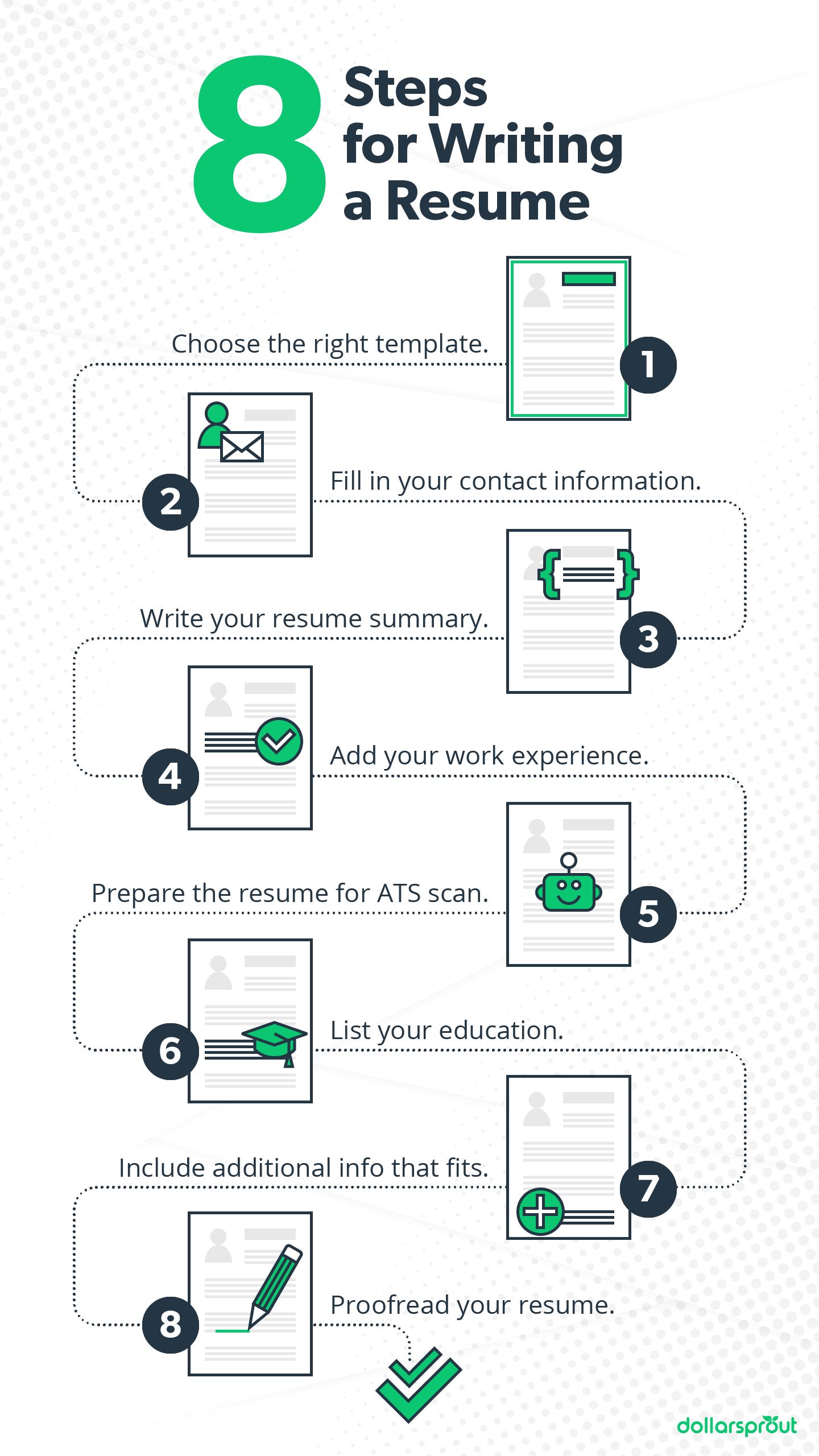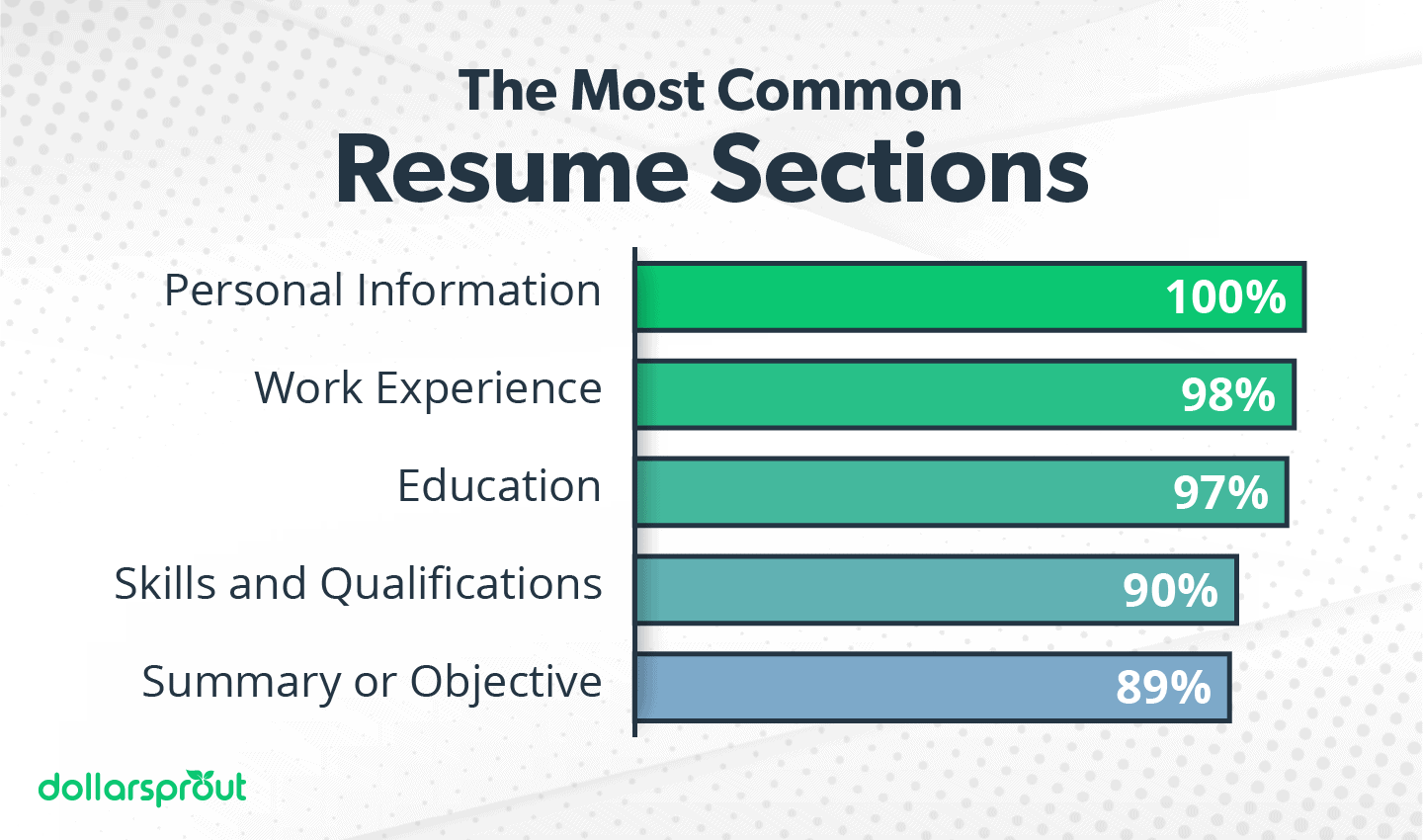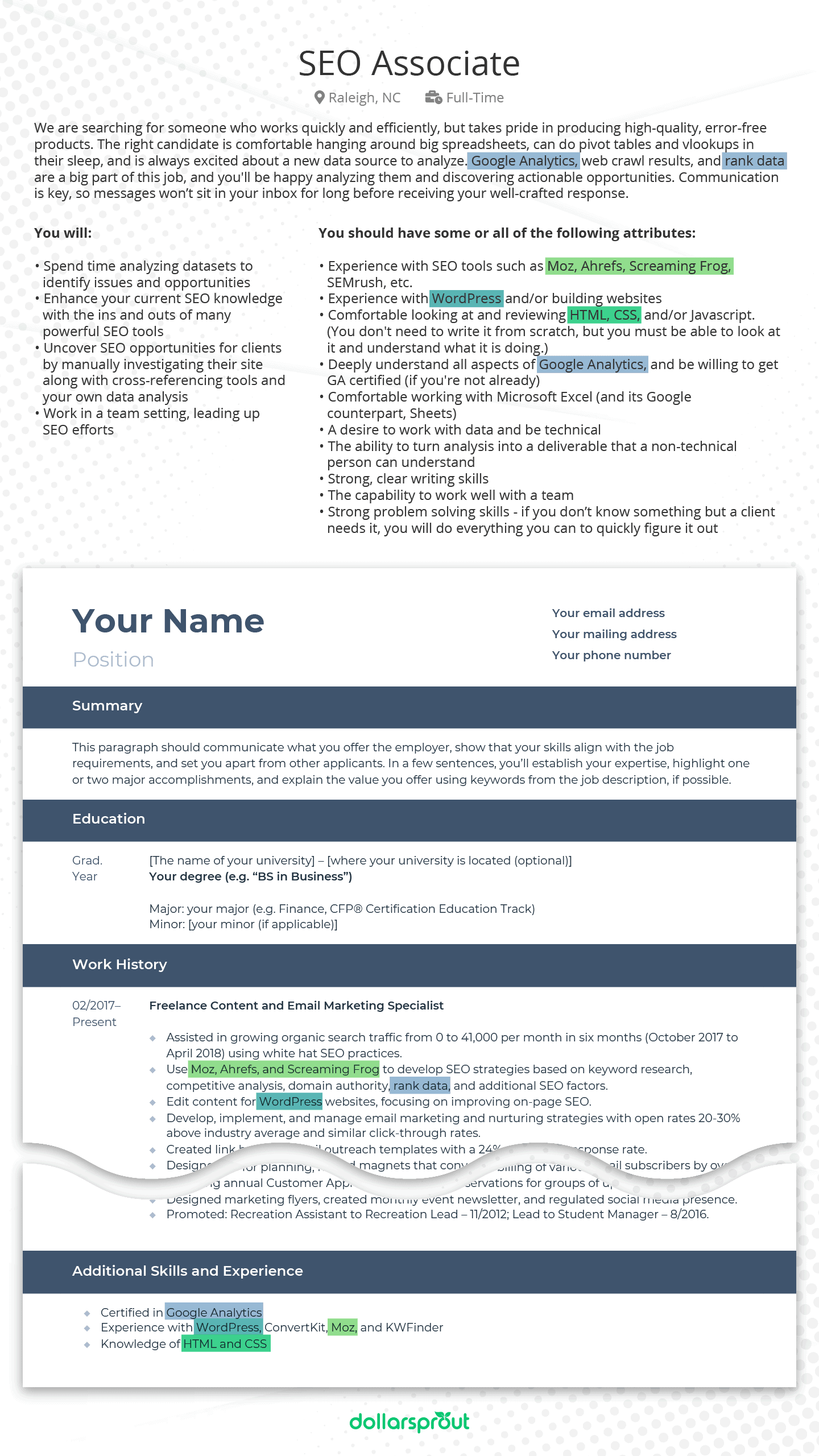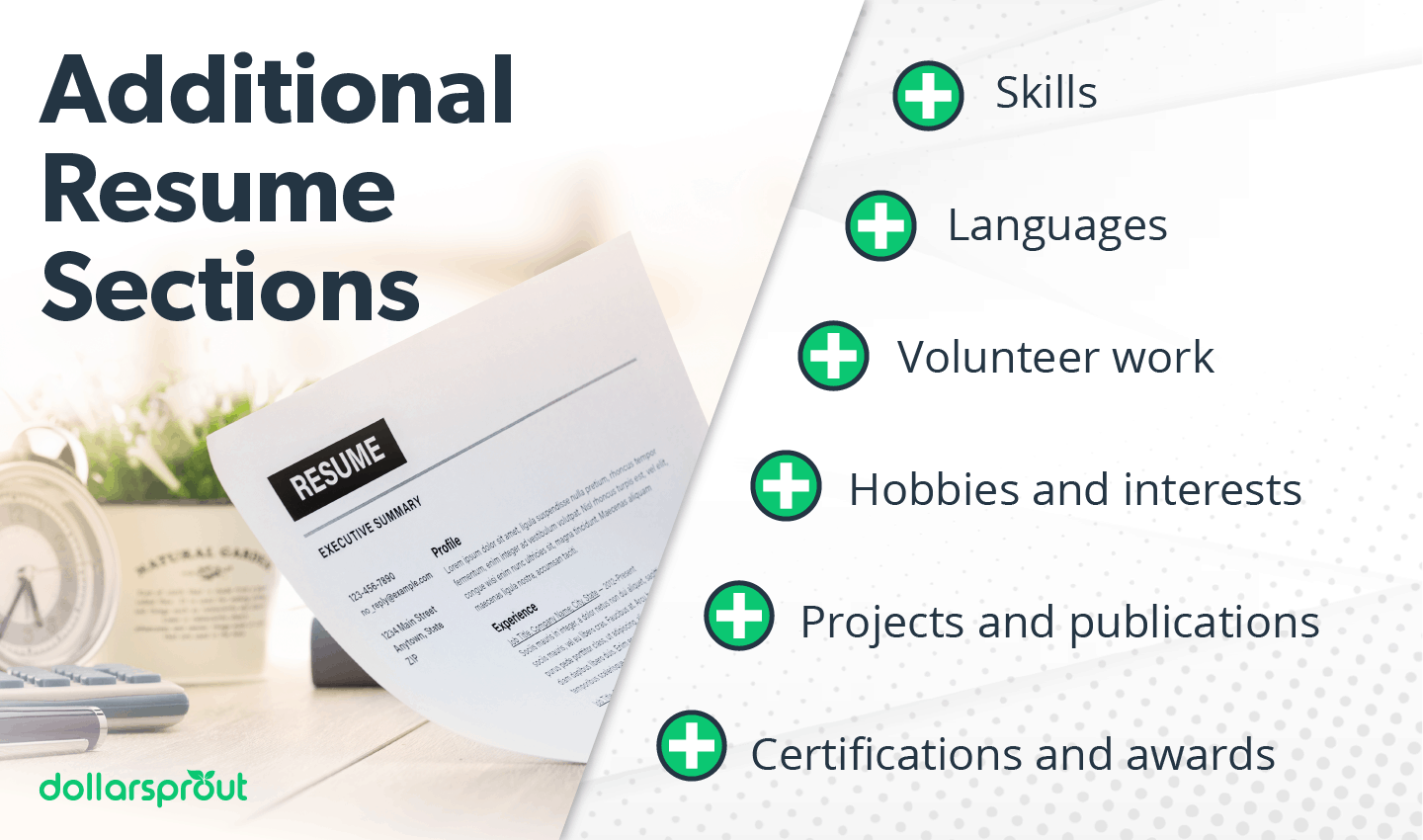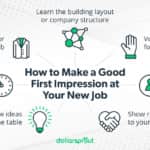How to Make a Resume in 8 Simple Steps
Our readers always come first
The content on DollarSprout includes links to our advertising partners. When you read our content and click on one of our partners’ links, and then decide to complete an offer — whether it’s downloading an app, opening an account, or some other action — we may earn a commission from that advertiser, at no extra cost to you.
Our ultimate goal is to educate and inform, not lure you into signing up for certain offers. Compensation from our partners may impact what products we cover and where they appear on the site, but does not have any impact on the objectivity of our reviews or advice.
You only have seconds to make an impression. Recruiters spend an average of 7.4 seconds scanning a resume, according to a study by Ladders Inc. That’s why it’s important to learn how to make a resume that will catch anyone’s eye.

Our mission at DollarSprout is to help readers improve their financial lives, and we regularly partner with companies that share that same vision. If a purchase or signup is made through one of our Partners’ links, we may receive compensation for the referral. Learn more here.
If you’re on the hunt for a new job, your resume is a crucial piece of your job application. Recruiters use this document to help them decide whether you move to the next phase of the hiring process. This means it must showcase your accomplishments and the value you can bring to the company.
But you only have seconds to make an impression. Recruiters spend an average of 7.4 seconds scanning a resume, according to a study by Ladders Inc.[1]
That’s why it’s important to learn how to make a resume that will catch anyone’s eye.
How to Make a Resume for Your First (or Next) Job
When you write a resume, it should be tailored to the job but also reflect your own experience and strengths. Whether you need to make a resume for your first job or you’re on to the next, these experts weigh in on how to get it right.
1. Choose the right resume format or template.
Before you build a resume, you need to decide which type of template to use. These provide a basic structure for your resume, so you simply edit to include your own information. The right template showcases your strengths and downplays your weaknesses.
There are three main types:
- Chronological: This template is best for someone with a steady, advancing career path with plenty of experience that’s relevant to the position. Write your job history starting with the most recent role at the top, moving in reverse-chronological order.
- Functional: This type of template emphasizes skills over job experience, so it might start with a summary followed by a list of skills and examples of using those skills. If you have gaps in your job history or you tend to quickly move from one role to the next, this is a good template for you.
- Combination: This combines aspects of the chronological and functional template, and it’s best if you want to emphasize skills but also need to list your previous roles. Lead with your qualifications and skills, followed by a reverse-chronological employment history.
“Unless you are in a major career change, I always recommend a reverse-chronological or a combination resume,” says Cassie Hatcher, certified professional resume writer. Employers tend to prefer these because they’re easy to scan and show you have the job experience for the role.
But you might decide to use a functional resume if you’ve had very similar roles without a lot of differentiation, says Kim Sarmiento, certified professional resume writer. That can help keep the resume from becoming very repetitive.
Microsoft Word and Google Docs both offer free resume templates. You can also use DollarSprout’s free resume template. For more help and sleeker designs, MyPerfectResume’s Resume Builder walks you through the exact step-by-step process of creating a resume. You choose a template you like, follow their prompts to add your resume content, and download your completed resume.
They’ll offer helpful suggestions along the way with pre-written examples you can customize based on your work experience. When you’re ready to download your resume, you can choose 14-day access for less than $3 or a monthly subscription of $5.95.
2. Fill in your contact information.
Even if you nail the rest of the resume, it won’t mean much without a contact section. Prospective employers need this information so they can schedule interviews and ask follow-up questions.
List the following information near the top:
- Name (and credentials, if relevant)
- Professional email address
- Phone number
- Location
- LinkedIn profile link
- Portfolio link (if relevant)
Recruiters commonly visit your LinkedIn profile next if they’re interested in knowing more, says Myra T. Briggs, executive search consultant and practice leader at Nonprofit HR.
“From the applicant’s perspective, it’s also a good way to track the interest your resume is generating by reviewing the ‘who’s viewed my profile’ section in your account,” Briggs adds.
Just make sure your LinkedIn profile is error-free and as well-written as the resume.
3. Write your resume summary.
Job seekers used to write their “objective” near the top of a resume, but Sarmiento says trends have shifted toward using a “summary.”
“Think of it as your 30-second commercial on paper,” Briggs says.
This paragraph should communicate what you offer the employer, show that your skills align with the job requirements, and set you apart from other applicants. In a few sentences, you’ll establish your expertise, highlight one or two major accomplishments, and explain the value you offer using keywords from the job description, if possible.
Here are some resume examples of a summary:
If you have extensive experience, Hatcher offers this example:
“Strategic operations and program manager with 20+ years leading government and military operations. Agile leader with proven success evaluating programs. Managed a $700K annual budget. Possesses a comprehensive background in program management and operations derived from directing domestic and global operations. Top Secret Security Clearance until July 2023. Sustained $4.6M in assets, property, and equipment while leading up to 1,100+ personnel.”
If you’re new to the job market, you can use a summary like this:
“Recent college graduate with a BA in journalism and political science and eight months’ campaign internship experience. Seeking to leverage knowledge and work experience to fill your campaign communications role. A dedicated worker aiming to help you achieve company goals and quickly take on more responsibility.”
If you’re changing careers, try to follow this example:
“Experienced and accomplished sales manager with 10 years’ experience looking to leverage an extensive background in customer service and leadership to an entry-level human resources position.”
4. Add your work experience.
The work experience section is the most important part of your job application because it “defines you as a candidate,” says Kathy Robinson, founder of TurningPoint, a company that provides career counseling. “Hiring teams look here to vet that you have the chops to fill the role.”
For each job, you’ll include the job title, company name and location, dates employed, and work responsibilities. When phrasing those responsibilities, Robinson says you should:
- Use keywords and language from the job description to help show you have experience doing the work that the job demands.
- Avoid writing in first person. Write in the past tense for previous jobs and present tense for current jobs.
- Use numbers where possible (such as percentages and dollar amounts) to show how you increased sales, leads, or results.
Here are some examples of ways to demonstrate on your resume how you helped solve a relevant problem and by how much:
Good:
- “In response to economic circumstances and increased competition, reorganized sales operations to consolidate teams and deliver sales efficiency, resulting in combined growth of product and services pipeline expected to contribute multi-year revenue of $10M. Exceeded sales KPI by 10% for the quarter.” (from Kathy Robinson)
- “Executed the transition plan to relocate the North American corporate headquarters (from Boston to Houston), resulting in a $4M annual cost savings.” (from Kim Sarmiento)
- “Automated analysis and cleanup of 30 million general ledger line items through adoption of an AI tool, reducing labor hours 30%.” (from Kim Sarmiento)
Needs work:
- “Reached out to potential customers over the phone or email to maintain relationships and upsell products. Tracked and reported leads for three months.”
- “Reorganized and consolidated sales operations, which led to company-wide savings.”
- “Analyzed labor hours and made suggestions for consolidation, resulting in savings.”
If you need help coming up with relevant statistics, Hatcher says you can ask yourself:
- Did I increase sales? If so, by what percentage or amount?
- Did I generate new business, bring in new clients, or forge affiliations?
- Did I save the company money? If so, how much?
- Did I create or institute any new system or process? If so, what were the results?
“You can roll up multiple years if need be, or add things together, or even talk about expected revenue,” Robinson says. “You also always want to tie the number to a business problem that is relevant to the current economy and the company in question.”
If it’s your first full-time job or you’re fresh out of school, you can list other relevant experience such as volunteer work, part-time jobs, or leadership roles.
Related: 10 Resume Mistakes to Avoid (and What to Do Instead)
5. Tailor your resume to the job.
Before your resume reaches a recruiter’s eyes, it typically goes through an electronic applicant-tracking system (ATS) to rank resumes and weed out candidates who don’t fulfill the basic requirements.
You can get through this initial scan by looking for keywords and phrases in the job posting and weaving them throughout your resume and other parts of your job application like the cover letter. These descriptions “are basically cheat sheets that you have right in front of you — use them,” Briggs says.
First, read through the job posting to understand the employer’s needs and check out their website to get a feel for their brand and values. Then, look through listings for the same position at different companies. Pick out the most popular keywords and phrases. But because ATS machines also uncover keyword spamming, make sure you use the keywords naturally.
Here’s an example of how to use keywords from a job description in your resume:
6. List your education.
Typically, recruiters are more interested in your recent work achievements than your educational accomplishments. But the education section is important because it shows employers you meet the academic requirements for the role.
Make sure to include the university name, type of degree(s), major(s) and minor(s), and years attended. In addition, you should also:
- List your highest degree first and others in reverse-chronological order.
- If you’re a new graduate, list this first above work experience.
- Only list high school information if you don’t have a university degree.
- Mention GPA if you’re a new graduate and have a 3.5 or higher.
- If you’ve completed some college, list relevant completed credits.
Feel free to leave out the years attended, Sarmiento says. When working with clients, she only includes this detail if she needs to explain why the applicant has less than 10 years’ experience.
7. Include additional resume sections that fit the job.
You can write a good resume using the sections covered so far — they’re must-haves for any job application. But adding some additional information can round you out as the best candidate.
Skills
Job skills should be included throughout your resume, mainly in your summary and previous roles.
But you might need a special “skills” section if you couldn’t find a good place for one. This usually happens if you’re changing careers and your previous work experience doesn’t reflect skills you picked up outside of your jobs.
In this section, you can list hard skills needed for the job, such as your proficiency with industry software or a certification to run machinery, or soft skills that any employer will look for.
If possible, list your proficiency level for each skill (e.g., beginner, intermediate, expert).
Languages
This section on your resume includes the languages you speak and your proficiency.
You can define your mastery of the language as basic, conversational, proficient, or fluent. But you’ll also want to include your specific language skills, which include reading, writing, speaking, and listening.
If the job doesn’t have language requirements, you can list any level of proficiency, Sarmiento says. But if the employer does need you to use those skills at work, only include languages if you’re proficient or fluent.
Hobbies, interests, and extracurricular activities
This section can showcase skills that are relevant to the role, Sarmiento says. For instance, if you’re a computer salesperson and an avid motorcycle rider and you’re applying for a sales position at a motorcycle company, “you might want to list [motorcycle riding] as a hobby on your resume and go into some details in your cover letter,” she says.
If your hobbies don’t align with the position but you feel they’ll help you stand out as a candidate, you don’t have to list them on your resume. “LinkedIn is a great place to share your personality,” Hatcher says. “Are you a deep-sea diver, Eagle Scout, or avid gardener? Share it in your (LinkedIn) summary section.”
You can also save other interesting hobbies for the interview, Briggs suggests. “Surely a question about what interests you will come up during any conversations with recruiters.”
Volunteer work
In this section of your resume, list volunteer roles if they’re relevant to the job or the company’s mission. This section can be a good stand-in if you don’t have much work experience or you’re switching careers and you have volunteer experience in your new field.
“Volunteer work is most relevant when it ties to your community (or network) or what you want to do professionally,” Sarmiento says.
But you’ll need to prioritize. Resumes are typically one or two pages, so if you’ve run out of room, list your volunteer work on LinkedIn and leave it off your resume.
Certifications and awards
Here’s where you list relevant honors you earned along with certifications that show you’re proficient in a particular skill.
Listing certifications can be especially helpful if you’re changing careers or don’t have much experience in the field you’re applying to. For example, if you work in finance and you’re applying for an SEO-marketer position, then being Google Analytics-certified would give you some credibility.
Awards can help demonstrate soft skills such as problem-solving abilities, leadership, and teamwork. List these if they’re relevant to the position and can help you stand out.
Projects and publications
If you’ve worked on a big project, you were featured in a major publication, or you write as a side hustle, you can list these accomplishments in a special section.
These can show you have a passion in your field and help set you apart. If you’re applying to a newspaper job, for example, you can list a book you wrote. For any publication or project, list a URL if possible so the recruiter or hiring company can check it out. If you’re a graphic designer or other type of artist, portfolio websites can be a good way to showcase your skills, or you can list them on LinkedIn.
8. Proofread your resume before sending.
Before the interview, your resume might be the only connection you have with the employer. Make a strong impression by checking your resume several times before submitting to the hiring company.
“If you have typos or formatting errors, they are likely to assume that your attention to detail is sub-par, and that could hurt your standing with key stakeholders,” Robinson says.
In fact, 77% of employers immediately disqualify resumes for spelling and grammatical errors, according to a CareerBuilder survey.
Give yourself a few days to run these checks:
- Once you’ve written the resume, use editing tools such as Grammarly to catch errors.
- Print the resume and proofread it yourself. Check for formatting issues, too.
- Ask a friend, family member, or mentor to proofread the resume and give feedback.
- Prepare the resume as a PDF unless instructions say otherwise.
Put aside time for a final line-by-line check before sending it out, Robinson says. It should be as perfect as possible.
Keep Your Resume Simple and Relevant
As you write the resume, focus on what’s most important. It’s a balance between showing you can do the job, amplifying strengths that set you apart, and doing all of this in as little space as possible. Most resumes are one page, but you can stretch to two pages if you have extensive experience.
Keep the format simple, too. In the Ladders Inc. study, the best resumes had simple layouts, clearly-labeled sections, bold keywords, and bulleted lists.
“It’s your job to make sure your resume’s simple, succinct, and customized for each employer,” Robinson says, “so it’s easy for them to read, easy for them to know what you can do, and easy for them to pick up the phone and call you in for an interview.”


